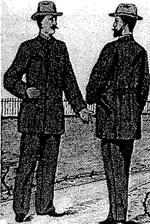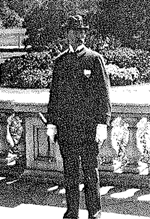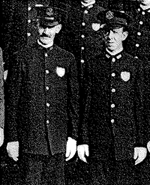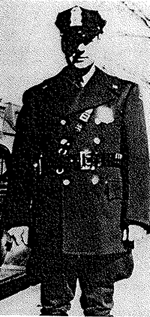


By the late 1920s, gray, heavy cotton long-sleeve shirts came into use for year-round wear. They were said to have been particularly uncomfortable in the summer months and perpetually in need of pressing. Officers were cautioned to protect the blue wool uniform outerwear from moth damage. This fabric was replaced in the late 1940s by a durable serge twill material.
The first shoulder patch to make an appearance was the motorcycle officers' "winged wheel" of the late 1920s. Horse mounted officers adopted a specialized unit patch of their own at a later date. No Force-wide uniform patch existed prior to 1940.
In the 1930's through the 1950's, Corporal and Sergeant stripes were displayed with the chevrons pointing up. However, Chief Harold F. Stewart ordered that the Sergeant’s stripes be inverted once again to point downward in conjunction with the next uniform restyling.

The most dramatic uniform revision for the Park Police occurred in 1960. Conversion to the new style was complete by January 1961 when the entire Force sported its new uniform for President Kennedy's inauguration. It incorporated black trousers with a blue stripe down the outside of each leg, sky blue shirts, and a Pershing hat. The blouse, which was Marine cut, became the outer garment for spring and fall. In 1973, "Blauer" jackets replaced the double-breasted overcoat as winter wear. The current style of ties and tie tacks, along with paratrooper boots for scooter officers, were also introduced that year.
Women on the job held non-uniformed positions until the early J970's with the appointment of Judy Schuster and Paulette Tubbs. They were initially outfitted with a hat modeled after the Navy WAVES cap, a crossover tie, blouse, and skirt, but transitioned incrementally to the standard uniform worn by their male counterparts over the next few years.
Law and Order Magazine announced the winners of the "Best Dressed Police Department" awards program in 1989, sponsored by the National Association of Uniform Manufacturers and Distributors. A panel of judges made their selections on the basis of image projection, immediate recognition, reflection of the authority and professionalism of the department, practicality for police work, protection from weather and physical attack, policies requiring uniform and appearance standards, and regular inspections.
The History of the Patch
Although there have been a variety of specialized unit patches over the years, the United States Park Police has only had three basic uniform patch designs throughout its history. The first was a triangular shape of simple design having a black background with "U.S. Park Police" in yellow lettering surrounded by a yellow border. It made its appearance about 1940 and was worn exclusively on outer garments and not on the uniform shirts.
Transition to the second shoulder insignia occurred early in 1951. The patch was initially manufactured in rectangular form that was intended to be affixed to uniform overcoats, blouses and sweaters with each corner folded under as it was attached to present an octagonal appearance. Later versions were precut to those specifications and featured the official United States eagle seal on a dark blue background. It was intended to blend with the blue of the uniform to give the illusion of an embroidered design directly on the garment when viewed from a distance. Soon after its introduction, display of the patch was expanded to include the uniform shirt.
The current shoulder patch was adopted in conjunction with a fundamental design change of the uniform implemented in 1960. It incorporated the same basic shape and emblem as the earlier version on a background of white and a thin dark blue border for uniform shirts and overcoats. An identical insignia with the exception of a white wool felt background and light blue border is displayed on the dress uniform blouse.
U.S. Park Police Patches
View pictures of patches that have been worn on the U.S. Park Police uniform.
Last updated: February 26, 2015
